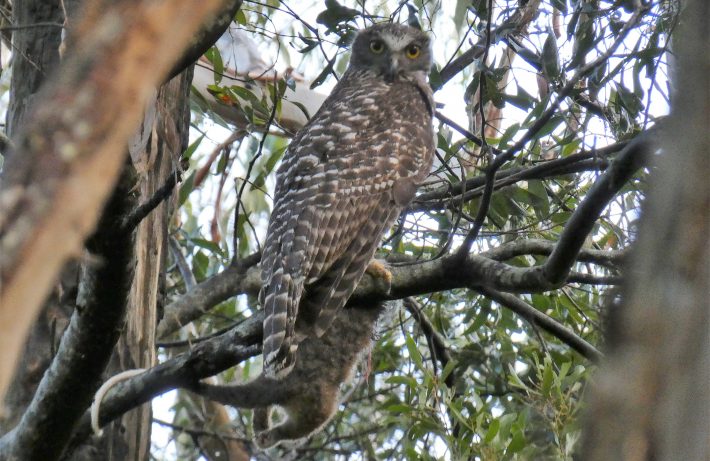Scientists call for improved management of a weedy tree to protect owl habitat
Monash University press release.
Research by Monash University scientists shows hat the richness and abundance of birds is much reduced in areas with dense canopies of Pittosporum, an the invasive understorey tree. The findings are published in Ecological Solutions and Evidence.

When is a weed not a weed? Can native plants be weeds?
Sweet pittosporum (Pittosporum undulatum) was once a well-behaved tree growing in gullies from Gippsland in Victoria up to Brisbane in Queensland.
But it is now a major problem, leading to an almost complete suppression of native vegetation where it has invaded. Programs to clear it have successfully allowed indigenous plants to return, and within 15 years, with moderate follow up, treated sites are well on the way to successful restoration.
However, there has been some debate on whether this is good or bad for birds such as the threatened Powerful Owl.
New research by Monash University scientists from the School of Biological Sciences published today in Ecological Solutions and Evidence shows that the richness and abundance of birds is much reduced in areas with dense Pittosporum canopies.
“The almost complete absence of any understory vegetation and no ground cover means there is very little for birds to eat in invaded sites,” said lead study author Dr Ben O’Leary, who conducted the surveys as part of his PhD.
“Most habitat components for birds exists within the Eucalyptus overstorey and mid canopy. The presence or removal of Pittosporum doesn’t appear to greatly influence ground storey bird species, which have been in long-term decline.”
The study found that there are also fewer carnivorous birds in Pittosporum-invaded sites, probably because there is less prey on the ground and the dense Pittosporum canopy makes it hard for these large birds to navigate through these areas.
The trick is balancing the progression of weed control with the retention of enough structure to support local plants and animals
“While invaded sites are not great habitat, restoration projects need to ensure that the full range of habitats continue to be available during the transition period,” Dr O’Leary said.
One difficulty in overseeing the removal of an invasive tree species is that these trees, in certain circumstances, provide structural value to local flora and fauna. There is a lag time between the invaders’ removal and its replacement by indigenous alternatives.
“The trick is balancing the progression of weed control with the retention of enough structure to support local plants and animals,” Dr O’Leary said.
Project leader and co-author Professor Ros Gleadow also from the School of Biological Sciences, has been studying Pittosporum for over 40 years.
“It is important to get rid of the Pittosporum now,” Professor Gleadow said.
“Not only does it suppress the understorey, but in all these years, I have never seen a eucalypt seedling growing under a Pittosporum canopy,” she said.
“Once the old eucalypts at a site die, that’s it and it of both native vegetation and birds is impossible without major intervention”.
Previous work by the group showed that areas can be restored to their original state if there are healthy remnant sites nearby.
“For areas where Pittosporum is native, like around Sydney, management is philosophically complicated but there is no doubt that clearing will to help preserve biodiversity,” Professor Gleadow said.
Progressively clearing the Pittosporum over time, leaving some canopy in place in adjacent areas has the double benefit of providing potential roosting sites for the Powerful Owls, as well as increasing the number of prey.
Once the new shrubs and trees have grown, then clearing could progress to the next area.
You can read the full article for free here:
, , , & (2021). Bird community recovery following removal of an invasive tree. Ecol Solut Evidence, 2, e12080. https://doi.org/10.1002/2688-8319.12080
Like what we stand for?
Support our mission and help develop the next generation of ecologists by donating to the British Ecological Society.